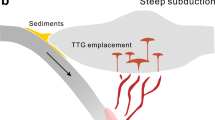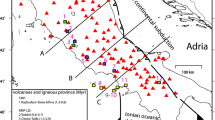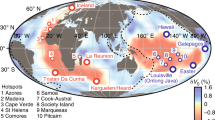Abstract
The thermochemical structure of the subcontinental mantle holds information on its origin and evolution that can inform energy and mineral exploration strategies, natural hazard mitigation and evolutionary models of Earth. However, imaging the fine-scale thermochemical structure of continental lithosphere remains a major challenge. Here we combine multiple land and satellite datasets via thermodynamically constrained inversions to obtain a high-resolution thermochemical model of central and southern Africa. Results reveal diverse structures and compositions for cratons, indicating distinct evolutions and responses to geodynamic processes. While much of the Kaapvaal lithosphere retained its cratonic features, the western Angolan–Kasai Shield and the Rehoboth Block have lost their cratonic keels. The lithosphere of the Congo Craton has been affected by metasomatism, increasing its density and inducing its conspicuous low-topography, geoid and magnetic anomalies. Our results reconcile mantle structure with the causes and location of volcanism within and around the Tanzanian Craton, whereas the absence of volcanism towards the north is due to local asthenospheric downwellings, not to a previously proposed lithospheric root connecting with the Congo Craton. Our study offers improved integration of mantle structure, magmatism and the evolution and destruction of cratonic lithosphere, and lays the groundwork for future lithospheric evolutionary models and exploration frameworks for Earth and other terrestrial planets.
This is a preview of subscription content, access via your institution
Access options
Access Nature and 54 other Nature Portfolio journals
Get Nature+, our best-value online-access subscription
$29.99 / 30 days
cancel any time
Subscribe to this journal
Receive 12 print issues and online access
$259.00 per year
only $21.58 per issue
Buy this article
- Purchase on Springer Link
- Instant access to full article PDF
Prices may be subject to local taxes which are calculated during checkout



Similar content being viewed by others
Data availability
The data that support the findings of this study are available from the community data repository Figshare at https://doi.org/10.6084/m9.figshare.19322180.
Code availability
The codes used to perform the inversions are available from the corresponding author upon request or via https://www.juanafonso.com/.
Change history
16 January 2023
A Correction to this paper has been published: https://doi.org/10.1038/s41561-023-01124-3
References
Griffin, W., Begg, G. & O’Reilly, S. Continental-root control on the genesis of magmatic ore deposits. Nat. Geosci. 6, 905–910 (2013).
Holwell, D. A. et al. A metasomatized lithospheric mantle control on the metallogenic signature of post-subduction magmatism. Nat. Commun. 10, 3511 (2019).
Craig, T. J., Jackson, J. A., Priestley, K. & McKenzie, D. Earthquake distribution patterns in Africa: their relationship to variations in lithospheric and geological structure, and their rheological implications. Geophys. J. Int. 185, 403–434 (2011).
Hoggard, M. J. et al. Global distribution of sediment-hosted metals controlled by craton edge stability. Nat. Geosci. 13, 504–510 (2020).
Begg, G. G., Hronsky, J. M. A., Griffin, W. L. & O’Reilly, S. Y. in Processes and Ore Deposits of Ultramafic-Mafic Magmas Through Space and Time (eds Mondal, S. K. & Griffin, W. L.) 1–46 (Elsevier, 2018).
Heinson, G. et al. The crustal geophysical signature of a world-class magmatic mineral system. Sci. Rep. 8, 10608 (2018).
Begg, G. et al. Lithospheric, cratonic, and geodynamic setting of Ni–Cu–PGE sulfide deposits. Econ. Geol. 105, 1057–1070 (2010).
Schutt, D. L. & Lesher, C. E. Effects of melt depletion on the density and seismic velocity of garnet and spinel lherzolite. J. Geophys. Res. 111, B05401 (2006).
O’Reilly, S. Y. & Griffin, W. L. Imaging chemical and thermal heterogeneity in the sub-continental lithospheric mantle with garnets and xenoliths: geophysical implications. Tectonophysics 416, 289–309 (2006).
Afonso, J. C. et al. On the Vp/Vs–Mg# correlation in mantle peridotites: implications for the identification of thermal and compositional anomalies in the upper mantle. Earth Planet. Sci. Lett. 289, 606–618 (2010).
Afonso, J. C. et al. 3-D multi-observable probabilistic inversion for the compositional and thermal structure of the lithosphere and upper mantle. I: A priori petrological information and geophysical observables. J. Geophys. Res. Solid Earth 118, 2586–2617 (2013).
Afonso, J. C., Fullea, J., Yang, Y., Connolly, J. A. D. & Jones, A. G. 3-D multi-observable probabilistic inversion for the compositional and thermal structure of the lithosphere and upper mantle. II: General methodology and resolution analysis. J. Geophys. Res. Solid Earth 118, 1650–1676 (2013).
Afonso, J. C. et al. 3-D multiobservable probabilistic inversion for the compositional and thermal structure of the lithosphere and upper mantle: III. Thermochemical tomography in the Western-Central US. J. Geophys. Res. Solid Earth 121, 7337–7370 (2016).
Hu, J. et al. Modification of the Western Gondwana Craton by plume–lithosphere interaction. Nat. Geosci. 11, 203–210 (2018).
Grand, S. Mantle shear-wave tomography and the fate of subducted slabs. Phil. Trans. R. Soc. A 360, 2475–2491 (2002).
Ritsema, J. & Van Heijst, H. J. Seismic imaging of structural heterogeneity in Earth’s mantle: evidence for large-scale mantle flow. Sci. Prog. 83, 243–259 (2000).
Fishwick, S. Surface wave tomography: imaging of the lithosphere–asthenosphere boundary beneath central and southern Africa? Lithos 120, 63–73 (2010).
Celli, N. L. et al. African cratonic lithosphere carved by mantle plumes. Nat. Commun. 11, 92 (2020).
Torsvik, T. H., Rousse, S., Labails, C. & Smethurst, M. A. A new scheme for the opening of the South Atlantic Ocean and the dissection of an Aptian salt basin. Geophys. J. Int. 177, 1315–1333 (2009).
Yuan, X. et al. Seismic structure of the lithosphere beneath NW Namibia: impact of the Tristan da Cunha mantle plume. Geochem. Geophys. Geosyst. 18, 125–141 (2017).
Jelsma, H. et al. Kimberlites from central Angola: a case study of exploration findings. In Proc. 10th International Kimberlite Conference (eds Pearson, G. D. et al.) 173–190 (Springer, 2012).
Giuliani, A. et al. Southwestern Africa on the burner: Pleistocene carbonatite volcanism linked to deep mantle upwelling in Angola. Geology 45, 971–974 (2017).
Hopper, E. et al. Preferential localized thinning of lithospheric mantle in the melt-poor Malawi Rift. Nat. Geosci. 13, 584–589 (2020).
Hoal, K. E. O. Samples of Proterozoic Fe-enriched mantle from the Premier kimberlite. Lithos 71, 259–272 (2003).
Kobussen, A. F., Griffin, W. L. & O’Reilly, S. Y. Cretaceous thermo-chemical modification of the Kaapvaal cratonic lithosphere, South Africa. Lithos 112, 886–895 (2009).
Fritz, H. et al. Orogen styles in the East African Orogen: a review of the Neoproterozoic to Cambrian tectonic evolution. J. Afr. Earth Sci. 86, 65–106 (2013).
Eaton, D. W. et al. The elusive lithosphere–asthenosphere boundary (LAB) beneath cratons. Lithos 109, 1–22 (2009).
Link, K. et al. Continuous cratonic crust between the Congo and Tanzania blocks in western Uganda. Int. J. Earth Sci. 99, 1559–1573 (2010).
Rosenthal, A., Foley, S. F., Pearson, D. G., Nowell, G. M. & Tappe, S. Magmatic evolution at the propagating tip of a continental rift—a geochemical study of primitive alkaline volcanic rocks of the western branch of the East African Rift. Earth Planet. Sci. Lett. 284, 236–248 (2009).
Dawson, J. B. Quaternary kimberlitic volcanism on the Tanzania Craton. Contrib. Mineral. Petrol. 116, 473–485 (1994).
Alvarez, P. Evidence for a Neoproterozoic carbonate ramp on the northern edge of the Central Africa Craton: relations with late Proterozoic intracratonic troughs. Geol. Rundsch. 84, 636–648 (1995).
Crosby, A. G., Fishwick, S. & White, N. Structure and evolution of the intracratonic Congo Basin. Geochem. Geophys. Geosyst. 11, Q06010 (2010).
Kadima, E., Delvaux, D., Sebagenzi, S. N., Tack, L. & Kabeya, S. M. Structure and geological history of the Congo Basin: an integrated interpretation of gravity, magnetic and reflection seismic data. Basin Res. 23, 499–527 (2011).
Hartley, R. W. & Allen, P. A. Interior cratonic basins of Africa: relation to continental break-up and role of mantle convection. Basin Res. 6, 95–113 (1994).
Downey, N. J. & Gurnis, M. Instantaneous dynamics of the cratonic Congo Basin. J. Geophys. Res. 114, B06401 (2009).
Forte, A. M. et al. Joint seismic–geodynamic–mineral physical modeling of African geodynamics: a reconciliation of deep mantle convection with surface geophysical constraints. Earth Planet. Sci. Lett. 295, 329–341 (2010).
Griffin, W. L., Graham, S., O’Reilly, S. Y. & Pearson, N. J. Lithosphere evolution beneath the Kaapvaal Craton. Re–Os systematics of sulfides in mantle-derived peridotites. Chem. Geol. 208, 89–118 (2004).
Capitanio, F. A., Nebel, O. & Cawood, P. A. Thermochemical lithosphere differentiation and the origin of cratonic mantle. Nature 588, 89–94 (2020).
Dang, Z. et al. Weak orogenic lithosphere guides the pattern of plume-triggered supercontinent break-up. Commun. Earth Environ. 1, 51 (2020).
Cooper, C. M., Farrington, R. J. & Miller, M. S. On the destructive tendencies of cratons. Geology 49, 195–200 (2020).
Laske, G., Master, G., Ma, Z. & Pasyanos, M. Update on CRUST1.0—A 1-degree global model of Earth’s crust. Geophys. Res. Abstr. 15, EGU2013–2658 (2013).
Afonso, J. C., Salajegheh, F., Szwillus, W., Ebbing, J. & Gaina, C. A global reference model of the lithosphere and upper mantle from joint inversion and analysis of multiple data set. Geophys. J. Int. 217, 1602–1628 (2019).
Amante, C. & Eakins, B. W. ETOPO11 Arc-Minute Global Relief Model: Procedures, Data Sources and Analysis NOAA Technical Memorandum NESDIS NGDC-24 (National Geophysical Data Center, NOAA, 2009); https://doi.org/10.7289/V5C8276M
Goutourbe, B., Poort, J., Lucazeau, F. & Raillard, S. Global heat flow trends resolved from multiple geological and geophysical proxies. Geophys. J. Int. 187, 1405–1419 (2011).
Bonvalot, S. et al. World Gravity Map (International Gravimetric Bureau, 2012).
Kvas, A. et al. ITSG-Grace2018: overview and evaluation of a new GRACE-only gravity field time series. J. Geophys. Res. Solid Earth 124, 9332–9344 (2019).
Schaeffer, A. J. & Lebedev, S. Global shear speed structure of the upper mantle and transition zone. Geophys. J. Int. 194, 417–449 (2013).
Yang, Y., Li, A. & Ritzwoller, M. H. Crustal and uppermost mantle structure in southern Africa revealed from ambient noise and teleseismic tomography. Geophys. J. Int. 174, 235–248 (2008).
Adams, A. N. et al. Lithospheric instability and the source of the Cameroon Volcanic Line: evidence from Rayleigh wave phase velocity tomography. J. Geophys. Res. Solid Earth 120, 1708–1727 (2015).
O’Donnell, J. P., Adams, A., Nyblade, A. A., Mulibo, G. D. & Tugume, F. The uppermost mantle shear wave velocity structure of eastern Africa from Rayleigh wave tomography: constraints on rift evolution. Geophys. J. Int. 194, 961–978 (2013).
Herrmann, R. B. Computer Programs in Seismology v.3.30 http://www.eas.slu.edu/eqc/eqcsoftware.html (Saint Louis University, 2002).
Dalton, C. A., Ekström, G. & Dziewonski, A. M. The global attenuation structure of the upper mantle. J. Geophys. Res. 113, B09303 (2008).
Simmons, N. A., Forte, A. M., Boschi, L. & Grand, S. P. GyPSuM: a joint tomographic model of mantle density and seismic wave speeds. J. Geophys. Res. 115, B12310 (2010).
Schimmel, M. & Gallart, J. Frequency-dependent phase coherence for noise suppression in seismic array data. J. Geophys. Res. Solid Earth 112, B04303 (2007).
Li, G., Niu, F., Yang, Y. & Xie, J. An investigation of time-frequency domain phase-weighed stacking and its application to phase-velocity extraction from ambient noise’s empirical Green’s functions. Geophys. J. Int. 212, 1143–1156 (2018).
Sebai, A., Stutzmann, E., Montagner, J.-P., Sicilia, D. & Beucler, E. Anisotropic structure of the African upper mantle from Rayleigh and Love wave tomography. Phys. Earth Planet. Inter. 155, 48–62 (2006).
Ravenna, M., Lebedev, S., Fullea, J. & Adam, J. M.-C. Shear-wave velocity structure of southern Africa’s lithosphere: variations in the thickness and composition of cratons and their effect on topography. Geochem. Geophys. Geosyst. 19, 1499–1518 (2018).
Haario, H., Laine, M., Mira, A. & Saksman, E. DRAM: efficient adaptive MCMC. Stat. Comput. 16, 339–354 (2006).
Liu, J. S., Liang, F. & Wong, W. H. The multiple-try method and local optimization in Metropolis sampling. J. Am. Stat. Assoc. 95, 121–134 (2000).
Connolly, J. A. The geodynamic equation of state: what and how. Geochem. Geophys. Geosyst. 10, Q10014 (2009).
Stixrude, L. & Lithgow-Bertelloni, C. Thermodynamics of mantle minerals-II. Phase equilibria. Geophys. J. Int. 184, 1180–1213 (2011).
Brocher, T. M. Empirical relations between elastic wavespeeds and density in the Earth’s crust. Bull. Seismol. Soc. Am. 95, 2081–2092 (2005).
Acknowledgements
We thank S. Lebedev for valuable suggestions. We also acknowledge the AfricaArray programme and all its members. W.B.-M. and J.C.A. acknowledge funding from ARC Grant DP160103502, ARC CE110001017, ARC Linkage Grant LP170100233 and Macquarie University DVCR co-funding scheme. This is contribution 1681 from the ARC Centre of Excellence for Core to Crust Fluid Systems (www.ccfs.mq.edu.au) and 1480 in the GEMOC Key Centre (http://www.gemoc.mq.edu.au).
Author information
Authors and Affiliations
Contributions
J.C.A., N.J., A.M. and W.B.-M. conceived the project. W.B.-M., J.C.A., F.S. and I.F. performed the inversions and processed all datasets and results. All authors analysed the results and contributed to writing the manuscript.
Corresponding author
Ethics declarations
Competing interests
The authors declare no competing interests.
Peer review
Peer review information
Nature Geoscience thanks Sergei Lebedev, Atalay Ayele and the other, anonymous, reviewer(s) for their contribution to the peer review of this work. Primary Handling Editor: Rebecca Neely, in collaboration with the Nature Geoscience team.
Additional information
Publisher’s note Springer Nature remains neutral with regard to jurisdictional claims in published maps and institutional affiliations.
Supplementary information
Supplementary Information
Supplementary Text, Discussion and Figs. 1–29.
Supplementary Video 1
Supplementary video S1 is a video displaying a sequence of 2,500 random realizations of LAB depth from the full posterior distribution at a nominal resolution of 2° × 2°.
Supplementary Video 2
Supplementary video S2 is a video displaying a sequence of 2,500 random realizations of average lithospheric Mg# from the full posterior distribution at a nominal resolution of 2° × 2°.
Rights and permissions
Springer Nature or its licensor (e.g. a society or other partner) holds exclusive rights to this article under a publishing agreement with the author(s) or other rightsholder(s); author self-archiving of the accepted manuscript version of this article is solely governed by the terms of such publishing agreement and applicable law.
About this article
Cite this article
Afonso, J.C., Ben-Mansour, W., O’Reilly, S.Y. et al. Thermochemical structure and evolution of cratonic lithosphere in central and southern Africa. Nat. Geosci. 15, 405–410 (2022). https://doi.org/10.1038/s41561-022-00929-y
Received:
Accepted:
Published:
Issue Date:
DOI: https://doi.org/10.1038/s41561-022-00929-y
This article is cited by
-
Geodynamics of continental rift initiation and evolution
Nature Reviews Earth & Environment (2023)



